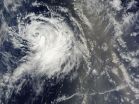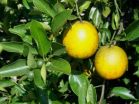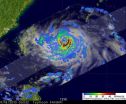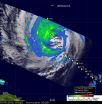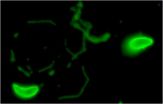(Press-News.org) Dust has been blowing into the Eastern Atlantic Ocean from Africa's Saharan Desert, and a NASA satellite captured some of that dust east of Tropical Storm Julia.
NASA's Moderate Resolution Imaging Spectroradiometer (MODIS) instrument on the Terra satellite captured a visible image of Tropical Storm Julia on Sept. 18 at 13:50 UTC (9:50 a.m. EDT) and noticed a large area of Saharan dust over the Atlantic Ocean, to Julia's east.
On Sept. 20 at 5 a.m. EDT, Julia was still holding on to tropical storm status with maximum sustained winds near 45 mph. Julia was located about 1,165 miles west of the Azores Islands near 35.5 North and 47.9 West. Julia is moving east-northeast near 9 mph and is forecast to speed up. Julia's estimated minimum central pressure is 998 millibars.
In addition to dealing with Saharan dust, Julia is dealing with wind shear created by massive Hurricane Igor far to her west. That westerly wind shear continues to push Julia's strongest convection (rapidly rising air that forms the thunderstorms that power her) to the east of Julia's center of circulation. When a tropical cyclone doesn't "stack up" line an upright column, it loses its uniform spin, and tends to weaken.
The National Hurricane Center expects Julia to fade into a remnant low in a day or two. Computer models show two different scenarios after that, as some see Julia could be absorbed in the massive circulation of Hurricane Igor, while others keep Julia separate and becoming extratropical before dissipating over cooler waters.
Meanwhile, as the curtain begins to drop on Julia in the eastern Atlantic, another low pressure system is in the wings to create its own show. There's a low about 400 miles west of the Cape Verde Islands that is showing signs of organization today. It's moving northwestward and has an 80% chance of becoming a tropical depression in the next 48 hours. That low is one that NAA satellites are keeping a close eye on.
INFORMATION:
NASA sees Tropical Storm Julia getting 'dusted'
2010-09-21
ELSE PRESS RELEASES FROM THIS DATE:
NASA satellites and aircraft studied Hurricane Karl before it faded
2010-09-21
Hurricane Karl made landfall near Veracruz, Mexico on Friday, Sept. 17 and moved inland over Mexico's rugged terrain, which took the punch out of the storm. As Karl was moving into Mexico, NASA aircraft and NASA satellites were gathering data from this storm that jumped from a tropical storm to a Category 3 hurricane the day before.
Karl had maximum sustained winds of 115 mph when it made landfall on Friday afternoon, Sept. 17. That made Karl a Category three hurricane on the Saffir-Simpson scale, and a major hurricane to boot.
On that day, NASA's Genesis and Rapid ...
Winter drought stress can delay flowering, prevent fruit loss in orange crops
2010-09-21
LAKE ALFRED, FL—Successful mechanical harvesting of perennial fruit crops requires efficient, economical harvesting systems that do not reduce trees' production life or diminish fruit quality. Most of the world's citrus is now harvested manually, but the use of efficient and lower-cost mechanical harvesting techniques is expected to increase in the next few years, especially in the large citrus plantations in Florida and Brazil. The citrus industry is ramping up efforts to extend the harvest season past June, when the following year's crop becomes large enough to be susceptible ...
NASA captures very heavy rain in Typhoon Fanapi and 2 landfalls
2010-09-21
Taiwan experienced a landfall and a soaking from Typhoon Fanapi, and NASA and JAXA's TRMM satellite noted a large area of very heavy rain in the system before it made landfall this weekend. NASA's Aqua and Terra satellites also captured impressive visible images of Fanapi just before the Taiwan landfall, and as it was making landfall in eastern China very early today.
The Tropical Rainfall Measuring Mission satellite known as TRMM captured an image of Typhoon Fanapi's rainfall on Sept. 18 at 0653 UTC (2:53 a.m. EDT) after the typhoon had intensified to 105 knots (~121 ...
Introducing 'Champagne', new disease-resistant fig
2010-09-21
BATON ROUGE, LA—The ancient fig tree, first imported to the United States during the 16th century, thrives in areas of California and the South Atlantic and Gulf Coast areas of the U.S. One of the most popular trees grown in Southern backyards, fig is favored for its versatile fruit and low-maintenance production.
Charles E. Johnson, Ed O'Rourke, and James E. Boudreaux, from the Louisiana State University Agricultural Center in Baton Rouge, introduced a new fig they named "Champagne" in a recent issue of HortScience. According to the report, the new fig performed well ...
NASA's MODIS and AIRS instruments watch Igor changing shape, warming over 3 days
2010-09-21
The Moderate Resolution Imaging Spectroradiometer or MODIS, is an instrument that flies on NASA's Aqua and Terra satellites and provides incredible views of tropical cyclones like Hurricane Igor, from its vantage point in space. Imagery from the MODIS instruments on these two satellites captured from Sept. 18 to 20 showed that powerful Hurricane Igor in the Atlantic Ocean is morphing from a rounded storm to more of a comma-shaped storm.
The MODIS instrument on NASA's Terra satellite captured a visible image of Igor at 11:30 am on Sept. 18, while MODIS in the Aqua satellite ...
Food for thought, er, well...
2010-09-21
Ever wonder why it's such an effort to forget about work while on vacation or to silence that annoying song that's playing over and over in your head?
Mathematicians at Case Western Reserve University may have part of the answer.
They've found that just as thinking burns energy, stopping a thought burns energy - like stopping a truck on a downhill slope.
"Maybe this explains why it is so tiring to relax and think about nothing," said Daniela Calvetti, professor of mathematics, and one of the authors of a new brain study. Their work is published in an advanced online ...
Low-calorie cheesecake? Why we have trouble estimating calories
2010-09-21
When it comes to estimating calorie counts, Americans aren't really on the ball. According to a new study in the Journal of Consumer Research, this may be because of the order in which we encounter the food.
"The sequence in which items are considered often influences our evaluations of these items," writes author Alexander Chernev (Northwestern University). "The focus on sequential estimation is important because many meals are ordered and consumed sequentially rather than at once. Moreover, to control their daily calorie intake, people often estimate not only the amount ...
Santa Fe homeowners weigh in on landscape preferences
2010-09-21
LAS CRUCES, NM—While municipalities may mandate communitywide water conservation measures, individuals—particularly homeowners—can make significant contributions to water conservation in urban environments. Hoping to provide urban planners with more information about how residents' landscape preferences affect municipal water supplies, a team from New Mexico State University surveyed homeowners in Santa Fe about their attitudes toward high desert plants. Rolston St. Hilaire, Dawn M. VanLeeuwen, and Patrick Torres reported on their study of residents' preferences for urban ...
Scientists uncover process enabling toxoplasmosis parasite to survive homelessness
2010-09-21
INDIANAPOLIS — The parasite responsible for toxoplasmosis requires a stress response system that helps it survive the move to infect new cells, Indiana University School of Medicine scientists have reported, a discovery that could lead to new treatments to control the disease.
Parasites such as Toxoplasma gondii invade host cells, replicate and then must exit to find new host cells to invade. Traveling outside their host cell exposes the parasites to environmental stresses that limit how long they can remain viable while searching for new host cells.
The researchers ...
Learning how consumers value products
2010-09-21
Suggesting to consumers that they will use a product frequently can actually reduce their interest in purchasing the product, according to a new study in the Journal of Consumer Research.
"When consumers estimate the value of a durable product, they consider not only the absolute number of times they think they will use the product, but also the number of time they will use the product relative to other consumers," write authors Rebecca W. Hamilton, Rebecca K. Ratner (both University of Maryland, College Park), and Debora Viana Thompson (Georgetown University).
The ...
